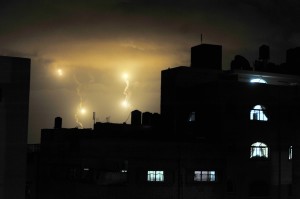BESA Center Perspectives Paper No. 270
EXECUTIVE SUMMARY: Frustration over the final outcome of Operation Protective Edge is misplaced. The Israeli public needs to understand that Israel did not set out to topple Hamas. Dealing Hamas a debilitating blow, eradicating the terror tunnels and rejecting any change in the status quo that defines Israel’s relations with Gaza, were the objectives of the operation. Having achieved all this, the operation’s result should not be thwarted.
Operation Protective Edge, which ended after 50 days of fighting and without the toppling of the Hamas regime in the Gaza Strip, has left many people frustrated.
This feeling stems from two reasons: the first is the Jewish tendency to see the glass half empty – we never seem to be happy with what we have. Many times it is this feeling that pushes us to do better and the Gaza campaign is no exception – Gaza’s rulers should be well aware of the fact that in this case, our glass is three-quarters full. The second reason is a gap in expectations. Many were under the impression that Israel had set out to topple the Hamas government in Gaza, or that this should have at least been declared as the operational objective. This mistaken impression can be attributed to the fact that no one explained how such a mission could be accomplished.
Once Hamas’ terror tunnels were destroyed, the government faced two options. It had to choose between seizing control of the Gaza Strip, as a way of ousting Hamas, or gradually intensifying the military campaign until a cease-fire agreement was reached.
The various statements calling to “cut off the snake’s head,” “deal Hamas a surprising blow” or “bolster Palestinian Authority President Mahmoud Abbas’ position,” were nothing but empty slogans that failed to explain how those goals should be achieved. After all, the military did not need the public’s advice on how to carry out the operation on the ground, or how to target senior Hamas operatives.
Some tried to be clearer, speaking of the need to “dissect the Strip” or “seize Gaza’s command and control centers and its weapons manufacturing sites,” but these suggestions did not take into account Gaza’s unique nature. “Dissecting” the Strip would only be the prelude to a wide-scale ground operation – otherwise there would be no point to it. Gaza’s north is relatively independent from its south, and the move would have made Israeli soldiers vulnerable from all directions. As for seizing the various command and control centers and weapon mills in Gaza, that would be impossible without first seizing control of most of its urban areas, as these sites are scattered across the Strip.
Once it was decided not to seize control of the Gaza Strip, that rule should have been upheld adamantly. That is why it would have been wrong to heed the demands for a wide-scale ground operation, which might have produced heroes and headlines, as well as several Hamas casualties, but it would have contributed nothing to the operation’s results – maybe even the opposite.
Such a move could have caused more harm than good. Had we chosen to embark on a ground operation only to eventually withdraw the troops as part of an agreement, and after having suffered multiple casualties, everyone would have asked why we decided to go into Gaza in the first place, and Hamas would have declared a victory over said withdrawal.
Israel made sure to reiterate the truth: The operational objective – other than eradicating the terror tunnel’s threat – was striking an agreement based on the principle of “quiet will be met with quiet.” Once it was made clear that Hamas had set its sights higher, demanding things like an airport and a seaport, Israel did the right thing by saying that if the negotiations were about more than a truce, then it too had a demand, namely the full demilitarization of the Gaza Strip. After all, if we were to discuss more of Hamas’ demands, it was only fair to discuss more of Israel’s demands as well.
Had the cabinet ordered the IDF to seize control of the Gaza Strip there is no doubt it would have executed that order in full and without hesitation, but there is no doubt that the decision that was eventually made was legitimate; some would say prudent and wise.
I do not wish to debate which of the two moves would have been better, or whether this was a choice between two evils. The important thing to remember is that once the decision was made, those making it were wise to stand their ground and refrain from zigzagging between options, which would have been a big mistake.
There is no need to be frustrated by the results of Operation Protective Edge. One needs to understand Israel’s objectives: dealing Hamas a debilitating blow, eradicating the terror tunnels, and rejecting any change in the status quo that defines Israel’s relations with Gaza and the limitations imposed on the Strip.
Having achieved all of this, there should be no frustration with the operation’s results – although there is no doubt that Israel needs to start preparing for the next Gaza campaign
Maj. Gen. (res.) Yaacov Amidror is the Greg and Anne Rosshandler Senior Fellow at the Begin-Sadat Center for Strategic Studies, and former national security advisor to the Prime Minister.
A version of this article was published yesterday in Israel Hayom in English and Hebrew.
BESA Center Perspectives Papers are published through the generosity of the Greg Rosshandler Family
Click here for a PDF version of this article
(Photo Credit: Flickr/The United Nations)


